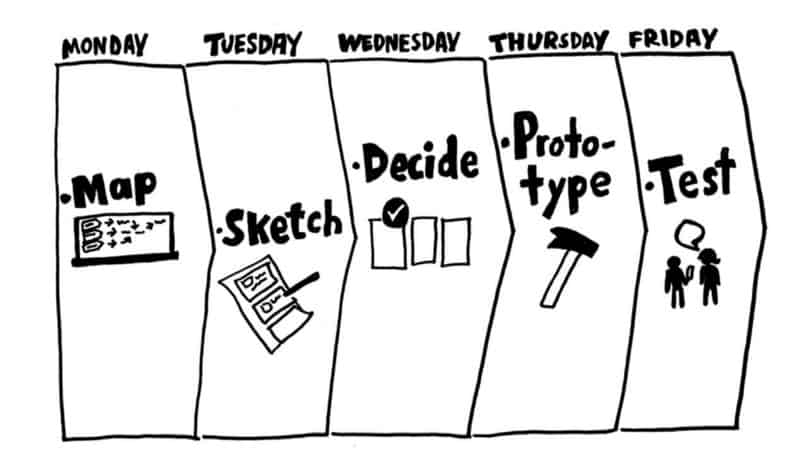In the spirit of continuous improvement, I’m always searching for ways to adapt and learn from prior experience. At Voltage Control, we run daily retrospectives with the client and internally to identify opportunities for enhancing our current methods, addressing flaws in our process, or ways to approach new problems.

Through regular reflection, we’ve identified numerous improvements and adaptations across all our workshops. I’m sharing seven of the most effective techniques for getting the most out of a Design Sprint.
1. Don’t Cut It Short
The most common and often misused Design Sprint hack is shortening the process to four or three days. This probably doesn’t come as a surprise as getting seven stakeholders to commit a week of their time can be a big challenge. While reducing the time commitment is alluring, tread carefully. There are many situations where a 5-Day is your best bet.

Design Sprints work so well because they focus the team and provide time to explore the problem thoroughly with a rapid deadline in sight. If you haven’t run a Design Sprint before, I suggest you run the full 5-Day version so that you can gain a deeper understanding of the principles and tools before you tweak the structure.
2. Practice Radical Candor
Always address the elephant in the room. Talk about things that may prevent the team from doing their best. Start each day off with an honest discussion about how to make the best of each day. Explore approaches that might improve engagement from team members who tend to be disconnected or less engaged.

3. Schedule Daily Recaps
The sprint team should review what went well and what could have been done better. Make room for improvement. It’s good practice to consider what you might stop doing, what you should start doing, and what you should change. At Voltage Control, we do this internally at the end of each day and with the client once a day or at least once, at the end of the week.

4. Conduct Office Hours
Conducting daily office hours is a great way to involve more members of your team without having your core Sprint team get too large. Simply invite them to attend daily office hours after the Sprint team is done for the day. Walk them through all of the assets and activities of the day. Answer any questions they may have. This typically takes only 30 minutes and will allow you to include more people in your process. They will feel more included and understand the process and typically go on to be advocates for the solution.

5. Shortcut the Storyboard
The storyboarding part of a sprint can be a messy process. Sketches often leave out details that are critical for building a prototype. The classic story boarding technique involves a group discussion focused around a storyboard drawn on the whiteboard. We recommend a more structured approach using the note and vote format. Each Sprint member writes down their ideal user flow and then shares it with the team. After everyone has shared, we vote on the best flow. This flow becomes the foundation for our storyboard on the whiteboard. Starting the storyboard in this way, allows everyone to individually think through the storyboard before we being group discussion. This hack also gives us a concrete starting point that we use to begin refining the details.

6. Pre-filter Content with Larger Groups
Jake Knapp (creator of the Design Sprint) advises us to limit the number of Sprint participants to seven. While it is possible to facilitate a larger group, it is important to consider the amount of content they will generate. When working with larger groups, I recommend having them pre-filter their content. Instead of sharing all their Sprint questions, they will just pick 2 or 3. Instead of posting all their “How Might We’s” on the wall, have them pick their top 5, 4, or 3. Depending on the number of participants, you can decide how much content is best.

7. Create an Interview Score Card
Taking notes on post-it notes results in a ton of… post-it notes! After generating all of these, we have to sort them. It is difficult to sort post-it notes while exhausted from a full day of listening to interviews. We’ve found that developing a score card that all users fill out during the interview, allows us to normalize our note taking. We often use Google sheets so that we have a digital copy of our scorecard and insights. This allows us to quickly synthesize the results post sprint. For teams that are likely to get distracted by their computer, we use a paper score card and have the results transcribed later.
Through our process of self examination, we find new ways to improve every day. The ones I’ve shared today are a few that I believe are the most helpful. We are always looking for new hacks and tricks and I would love to hear what you are up to! Please share your experiences in the comments.




